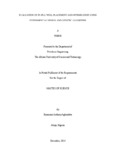| dc.contributor.author | Agbauduta, Emamuzo Anthony | |
| dc.date.accessioned | 2017-01-06T14:56:40Z | |
| dc.date.available | 2017-01-06T14:56:40Z | |
| dc.date.issued | 2014-12-12 | |
| dc.identifier.uri | http://repository.aust.edu.ng:8080/xmlui/handle/123456789/517 | |
| dc.description.abstract | Determination of optimal well locations for infill drilling is a challenging task because engineering and geologic variables affecting reservoir performance are often nonlinearly correlated and have some degree of uncertainty attached to them. Numerical models which are the basis of well placement decisions rely on data that are uncertain, which in turn translate to uncertainty in our numerical simulation forecasts.
The objective of this research is to employ an efficient optimization technique to the well placement problem to determine the optimum infill well location. Based on the success of its previous application by other authors in solving the well placement problems, Genetic Algorithm (GA) will be used here as the main optimization engine. An experimental design is used to generate some experimental simulation runs using the uncertain parameters, and these uncertain parameters are used to fit a response surface model of the objective function. The response surface methodology is used to identify the optimum design under conditions of uncertainty to build a proxy model that can be utilized to predict the cumulative oil produced. Our application of GA to determine the optimal location for infill well placement in a synthetic reservoir is improved by using a set of screening criteria and some engineering judgment to reduce the search space for possible locations. The proxy model generated from the response surface methodology is also combined with GA to determine the optimal locations for three cases of drilling two, four or six additional infill wells in the reservoir modeled in this study.
The study found that response surface models can be used as a proxy tool coupled with GA to provide reliable results; and to reduce the number of simulation runs required for the well placement optimization problem. | en_US |
| dc.description.sponsorship | AUST | en_US |
| dc.language.iso | en | en_US |
| dc.subject | Well placement | en_US |
| dc.subject | Agbauduta Emamuzo Anthony | en_US |
| dc.subject | 2014 Petroleum Engineering | en_US |
| dc.subject | Prof. David Ogbe | en_US |
| dc.title | Evaluation of in-fill Well Placement and Optimization Using Experimental Design and Genetic Algorithm | en_US |
| dc.type | Thesis | en_US |

